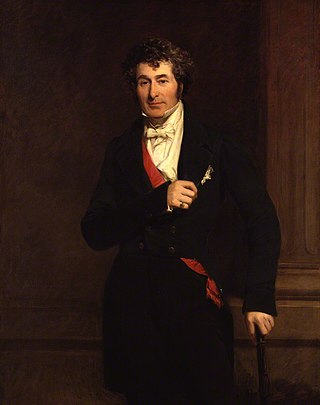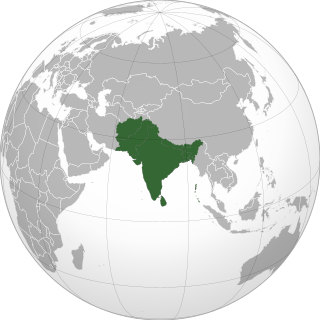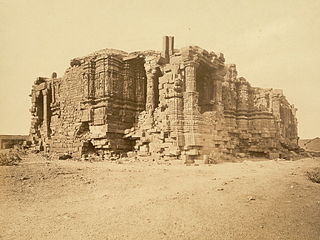
Edward Law, 1st Earl of Ellenborough, was a British Tory politician. He was four times President of the Board of Control and also served as Governor-General of India between 1842 and 1844.

Major-General Sir William Nott was a British military officer of the Bengal Army, East India Company in British India.

Ghazni, historically known as Ghaznain (غزنين) or Ghazna (غزنه), also transliterated as Ghuznee, and anciently known as Alexandria in Opiana, is a city in southeastern Afghanistan with a population of around 190,000 people. The city is strategically located along Highway 1, which has served as the main road between Kabul and Kandahar for thousands of years. Situated on a plateau at 2,219 metres (7,280 ft) above sea level, the city is 150 kilometres (93 mi) south of Kabul and is the capital of Ghazni Province. The name Ghazni drives from the Persian word "ganj", meaning ‘treasure’.

Manāt was a pre-Islamic Arabian goddess worshipped in the Arabian Peninsula before the rise of Islam and the Islamic prophet Muhammad in the 6/7th century. She was among Mecca's three chief goddesses, alongside her sisters, Allat and Al-‘Uzzá, and among them, she was the original and the oldest.

The Ghaznavid dynasty or the Ghaznavid Empire was a Persianate Muslim dynasty and empire of Turkic mamluk origin, ruling at its greatest extent from the Oxus to the Indus Valley from 977 to 1186. The dynasty was founded by Sabuktigin upon his succession to the rule of Ghazna after the death of his father-in-law, Alp Tigin, who was an ex-general of the Samanid Empire from Balkh.

The Grand Trunk Road is one of Asia's oldest and longest major roads. For at least 2,500 years it has linked Central Asia to the Indian subcontinent. It runs roughly 3,655 km (2,271 mi) from Teknaf, Bangladesh on the border with Myanmar west to Kabul, Afghanistan, passing through Chittagong and Dhaka in Bangladesh, Kolkata, Kanpur, Agra, Aligarh, Delhi, Amritsar in India, and Lahore, Rawalpindi, and Peshawar in Pakistan.

Abu al-Qasim Mahmud ibn Sabuktigin, usually known as Mahmud of Ghazni or Mahmud Ghaznavi, was Sultan of the Ghaznavid Empire, ruling from 998 to 1030. During his reign and in medieval sources, he is usually known by his honorific Yamin al-Dawla. At the time of his death, his kingdom had been transformed into an extensive military empire, which extended from northwestern Iran proper to the Punjab in the Indian subcontinent, Khwarazm in Transoxiana, and Makran.

The Somnath temple(IAST: somanātha) or Deo Patan, is a Hindu temple located in Prabhas Patan, Veraval in Gujarat, India. It is one of the most sacred pilgrimage sites the Tirtha Kshetra for Hindus and is the first among the twelve jyotirlinga shrines of Shiva. It is unclear when the first version of the Somnath temple was built, with estimates varying between the early centuries of the 1st millennium and about the 9th century CE. The temple is not mentioned in the ancient Sanskrit texts of Hinduism; while various texts, including the Mahabharata and Bhagavata Purana, mention a tirtha at Prabhas Patan on the coastline of Saurashtra, where the temple is presently located, there is no evidence that a temple existed at the site in ancient times.

The Agra Fort is a historical fort in the city of Agra, and also known as Agra's Red Fort. Mughal emperor Humayun was crowned at this fort in 1530. It was later renovated by the Mughal emperor Akbar from 1565 and the present-day structure was completed in 1573. It served as the main residence of the rulers of the Mughal dynasty until 1638, when the capital was shifted from Agra to Delhi. It was also known as the "Lal-Qila" or "Qila-i-Akbari". Before being captured by the British, the last Indian rulers to have occupied it were the Marathas. In 1983, the Agra fort was inscribed as a UNESCO World Heritage Site because of its importance during the Mughal Dynasty. It is about 2.5 kilometers (1.6 mi) northwest of its more famous sister monument, the Taj Mahal. The fort can be more accurately described as a walled city. It was later renovated by Shah Jahan.

Romila Thapar is an Indian historian. Her principal area of study is ancient India, a field in which she is pre-eminent. Thapar is a Professor of Ancient History, Emerita, at the Jawaharlal Nehru University in South West Delhi.

The Jat Regiment is an infantry regiment of the Indian Army, of which it is one of the longest-serving and most decorated regiments. The regiment has won 19 battle honours between 1839 and 1947, and post-independence it has won five battle honours, including 2 Victoria Cross, 2 George Cross, 8 Mahavir Chakra, 8 Kirti Chakra, 34 Shaurya Chakras, 39 Vir Chakras and 253 Sena Medals. During its 200-year service history, the regiment has participated in various actions and operations in India and abroad, including the First and the Second World Wars. Numerous battalions of the Jat Regiment, including the 14th Murray's Jat Lancers, fought in the First World War.

The Muslim conquests in the Indian subcontinent mainly took place between the 13th and the 18th centuries. Earlier Muslim conquests in the subcontinent include the invasions which started in the northwestern subcontinent, especially the Umayyad campaigns during the 8th century. Mahmud of Ghazni, Sultan of the Ghaznavid Empire, preserved an ideological link to the suzerainty of the Abbasid Caliphate and invaded vast parts of Punjab and Gujarat during the 11th century. After the capture of Lahore and the end of the Ghaznavids, the Ghurid ruler Muhammad of Ghor laid the foundation of Muslim rule in India in 1192. In 1202, Bakhtiyar Khalji led the Muslim conquest of Bengal, marking the easternmost expansion of Islam at the time.
Prabhas Patan, historically named Dev Patan, is a locality in Veraval, Gujarat. As the site of the Somnath temple and its associated Jyotirlinga, it is an important place of Hindu pilgrimage.

The Kabul Expedition was a punitive campaign undertaken by the British against the Afghans following the disastrous retreat from Kabul. Two British and East India Company armies forced through the Khyber Pass and advanced on the Afghan capital from Kandahar and Jalalabad to avenge the complete annihilation of the British-Indian military-civilian column in January 1842.
Kanhadadeva was a king belonging to the Chahamana dynasty, who ruled the area around Javalipura. Initially, he ran the administration jointly with his father Samantasimha, and helped ward off invasions from the Delhi Sultanate.

Veraval is a city and the headquarters of Gir Somnath district in the Indian state of Gujarat. Somnath temple, a place of pilgrimage due to its importance as Jyotirlinga site dedicated to Hindu deity Shiva, is located here. It is also known for the hub of fishing industries in India.

The coins of Mahmud Ghazni struck in India with Arabic and Sanskrit legends on obverse and reverse respectively, show a number of varieties in so far as the legends, the dates and the lettering and its arrangements are concerned.
Bhima I was a Chaulukya king who ruled parts of present-day Gujarat, India. The early years of his reign saw an invasion from the Ghaznavid ruler Mahmud, who sacked the Somnath temple. Bhima left his capital and took shelter in Kanthkot during this invasion, but after Mahmud's departure, he recovered his power and retained his ancestral territories. He crushed a rebellion by his vassals at Arbuda, and unsuccessfully tried to invade the Naddula Chahamana kingdom. Towards the end of his reign, he formed an alliance with the Kalachuri king Lakshmi-Karna, and played an important role in the downfall of the Paramara king Bhoja.
Meenakshi Jain is an Indian political scientist and historian who served as an associate professor of history at Gargi College, Delhi. In 2014, she was nominated as a member of the Indian Council of Historical Research by the Government of India. In 2020, she was conferred with the Padma Shri, India's fourth highest civilian award, for her work in the field of literature and education.

The Sack of Somnath in 1026 was a military campaign orchestrated by Mahmud of Ghazni, a ruler of the Ghaznavid Empire, directed against the Chaulukya dynasty of Gujarat. This is considered Mahmud's fifteenth invasion of India, which saw strategic captures and decisive battles and culminated in the destruction of the revered Somnath Temple. Facing staunch resistance, Mahmud's forces emerged victorious, resulting in significant casualties.















